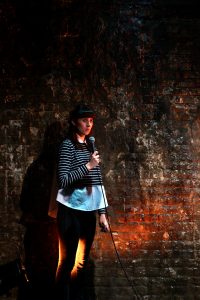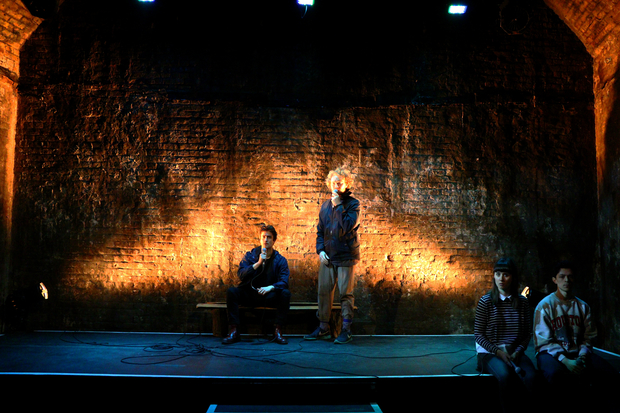OLIVIA LUNN reviews This Must Be The Place at the VAULT Festival.
Ripe with millennial cynicism, This Must Be The Place deconstructs the act of journeying and the motives for doing so amidst the suffocation of technology. Fittingly performed at the VAULT Festival under Waterloo Station, a show about individuals on the fringe of society is given the perfect introduction by the layers of graffiti that line the entrance tunnels protruding from Leake Street. With a fresh and captivating style that can feel both conversational and at times even like spoken word, collaborators Brad Birch and Kenneth Emson confront the audience with questions of identity, and its construction through our surrounding environment and people, through journeying, and through technology. All this is played out through the lenses of two separate yet interconnected stories. One is static: Matty (Hamish Rush) and Tate (Feliks Mathur) pass time reminiscing and speculating whilst waiting to embark upon a life-changing journey to London; the other is restless: Adam (James Cooney) is a disillusioned and grieving Londoner driven to Manchester to revisit the grave of his late father, ignoring his girlfriend Lily (Molly Roberts) and abandoning his phone.
Despite its initially jarring stop-start rhythm, as the focus switches between the two narratives, the play progressively picks up serious pace and the audience becomes immersed in each story. The two separate narrative spheres never explicitly engage with one another, but the four actors remain onstage throughout. This sense of connectedness within a world that sometimes seems distantly anonymous is communicated through the intimacy of the pit style stage, the communal benches for seating, as well as through the actors’ sustaining eye contact with the audience throughout.

Underwriting the two unfolding narratives is the looming presence of technology: Adam’s tale begins with him dropping his phone into the Thames, and explicitly comparing the loss to the “amputation of a limb or the loss of a parent”. This hyperbolic but nonetheless poignant moment maintains a certain unifying significance throughout Adam’s story and the wider piece. In Adam’s storyline, the absence of this vital component of modern life goes on to mutate into a haunting sense of guilt on account of his attempts to go off the radar, and as he reels off repeated voicemail messages, his tone ranges from meek and hushed to exasperated and repellent.
The absence of technology within the story is reflected in the staging: with noticeably minimal sound and lighting, the stage space was clearly intended to be a technology-free area. Indeed, Adam comically remarks upon the lack of phone signal in The Vaults, reminding the audience of their own dependence on technology. The narrative is consistently interrupted by Adam’s random outbursts of “like, comment, share, reply, tag”, another reminder of the inescapable presence of social media. Despite Adam’s wilful renunciation of the physical object he still cannot remove himself from the virtual realm most all of us now inhabit. In contrast, the only prop used in Tate and Matty’s ballad is a phone. A handful of texts received by Matty conjure up the presence of something terrifying yet hopeful – their ticket to life in London. However, miscommunication, ambiguity and fear ensue, leaving them vulnerable.
On another tack, This Must Be The Place repeatedly returns to family and parenthood. Whilst Tate intends to leave his current home as his ex-girlfriend is pregnant and he is unwilling to bear the responsibility of parenthood, Adam journeys to his father’s grave in attempt to come to terms with his grief. What pushes Tate away from one place, pulls Adam back to another, and their intertwined narratives reinforce the idea of an interconnected society; as the title insists, an individual’s state of mind is often shared by many, a common ‘place’.

Rush and Mathur skilfully portray the relationship between Matty and Tate, bouncing off one another in seamlessly scripted scenes to produce an energetic and moving performance. Cooney and Roberts deftly navigate a relationship much less at ease — largely tetchy and difficult. Lily is something of an accessory to Adam’s part and this inequality somewhat frustrates the fluidity of the performance.
This Must Be The Place succeeds in its direct confrontation with ideas of identity and technology through its stripped-back, unembellished rawness, and the cast’s delicate and sensitive portrayals of its characters. The characters are defined by their searching for new beginnings, something that might bring them some fulfilment, by their journeying. Is there a ‘place’ where we locate our identities? Or are we shaped by our journeys rather than their destinations? The play opens with the statement “This is not a London story. No. None of that here.” Nevertheless it feels local and particular, whilst it refreshingly steers clear of the clichés of young London we so often see in theatre.
This Must Be The Place played from 8th-12th Feb at the VAULT Festival (Jan 25th – Mar 5th2017). Find more information here.
Feature image courtesy of Matthew Foster.





